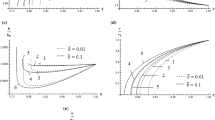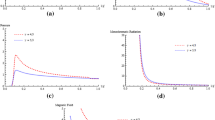Abstract
The propagation of a cylindrical shock wave under the influence of an azimuthal magnetic field in a rotating medium for adiabatic flow conditions is investigated using the Lie group transformation method. The density, magnetic field, and azimuthal and axial fluid velocities are assumed to vary in the undisturbed medium. The arbitrary constants appearing in the expressions for the infinitesimals of the local Lie group of transformations bring about different cases of solutions, i.e., with a power-law shock path, with an exponential-law shock path, and a particular case of a power-law shock path. Numerical solutions are obtained in the case of a power-law shock path and exponential-law shock path. The distributions of gasdynamical quantities are discussed based on figures. The effects of varying the values of the adiabatic exponent \(\gamma \), Alfven–Mach number \(M_\mathrm{A}^{-2}\), ambient azimuthal fluid velocity variation index \(\lambda _{1}\), and ambient density variation index \(\phi \) on the flow variables and shock strength are studied. With an increase in the adiabatic exponent or the strength of the magnetic field, the shock strength decreases. However, an increase in the ambient density variation index or ambient azimuthal fluid velocity variation index results in an increase in the shock strength. The numerical calculations are carried out using Mathematica software.



Similar content being viewed by others
Notes
Here the summation convention of summing repeated indices is used.
References
Nath G (2016) Propagation of a spherical shock wave in mixture of non-ideal gas and small solid particles under the influence of gravitational field with conductive and radiative heat fluxes. Astrophys Space Sci 361:31–44
Lin SC (1954) Cylindrical shock waves produced by instantaneous energy release. J Appl Phys 25:54–57
Chaturani P (1971) Strong cylindrical shocks in a rotating gas. Appl Sci Res 23:197–211
Nath G (2012) Self-similar solution of cylindrical shock wave propagation in a rotational axisymmetric mixture of a non-ideal gas and small solid particles. Meccanica 47:1797–1814
Nath G (2016) Propagation of exponential shock wave in an axisymmetric rotating non-ideal dusty gas. Indian J Phys 90:1055–1068
Vishwakarma JP, Nath G (2011) Cylindrical shock wave generated by a piston moving in a non-uniform self-gravitating rotational axisymmetric gas in the presence of conduction and radiation heat-flux. Adv Eng Res 2:537–576
Vishwakarama JP, Vishwakarama S (2007) Magnetogasdynamic cylindrical shock wave in a rotating gas with variable density. Int J Appl Mech Eng 12:283–297
Vishwakarma JP, Maurya AK, Singh KK (2007) Self-similar adiabatic flow headed by a magnetogasdynamic cylindrical shock wave in a rotating non-ideal gas. Geophys Astrophys Fluid Dyn 101(2):155–168
Hishida M, Fujiwara T, Wolanski P (2009) Fundamentals of rotating detonations. Shock Waves 19(1):1–10
Nath G (2011) Magnetogasdynamic shock wave generated by a moving piston in a rotational axisymmetric isothermal ow of perfect gas with variable density. Adv Space Res 47(9):1463–1471
Nagasawa M (1987) Gravitational instability of the isothermal gas cylinder with an axial magnetic field. Prog Theor Phys 77(3):635–652
Summers D (1975) An idealised model of a magnetohydrodynamic spherical blast wave applied to a flare produced shock in the solar wind. Astron Astrophys 45:151–158
Hartmann L (1998) Accretion processes in star formation. Cambridge University Press, Cambridge
Balick B, Frank A (2002) Shapes and shaping of planetary nebulae. Annu Rev Astron Astrophys 40(1):439–486
Lee TS, Chen T (1968) Hydromagnetic interplanetary shock waves. Planet Space Sci 16(12):1483–1502
Lerche I (1979) Mathematical theory of one-dimensional isothermal blast waves in a magnetic field. Aust J Phys 32(5):491–502
Lerche I (1981) Mathematical theory of cylindrical isothermal blast waves in a magnetic field. Aust J Phys 34(3):279–302
Shang JS (2001) Recent research in magneto-aerodynamics. Prog Aerosp Sci 37(1):1–20
Christer AH, Helliwell JB (1969) Cylindrical shock and detonation waves in magnetogasdynamics. J Fluid Mech 39(4):705–725
Pullin DI, Mostert W, Wheatley V, Samtaney R (2014) Converging cylindrical shocks in ideal magnetohydrodynamics. Phys Fluids 26(9):097103
Mostert W, Pullin DI, Samtaney R, Wheatley V (2016) Converging cylindrical magnetohydrodynamic shock collapse onto a power-law-varying line current. J Fluid Mech 793:414–443
Nath G, Singh S (2017) Flow behind magnetogasdynamic exponential shock wave in self-gravitating gas. Int J Non-Linear Mech 88:102–108
Bluman GW, Cole JD (1974) Similarity methods for differential equations. Springer, Berlin
Bluman GW, Kumei S (1989) Symmetries and differential equations. Springer, New York
Stephani H (1989) Differential equations: their solution using symmetries. Cambridge University Press, New York
Ibragimov NH (1999) Elementary lie group analysis and ordinary differential equations. Wiley, Chichester
Olver PJ (1993) Application of lie groups to differential equations, 2nd edn. Springer, New York
Hydon PE (2000) Symmetry methods for differential equations: a beginner’s guide. Cambridge University Press, London
Logan JD, Perez JDJ (1980) Similarity solutions for reactive shock hydrodynamics. SIAM J Appl Math 39(3):512–527
Donato A (1987) Similarity analysis and non-linear wave propagation. Int J Non-Linear Mech 22(4):307–314
Torrisi M (1988) Similarity solution and wave propagation in a reactive polytropic gas. J Eng Math 22(3):239–251
Zedan HA (2002) Applications of the group of equations of the one-dimensional motion of a gas under the influence of monochromatic radiation. Appl Math Comput 132(1):63–71
Donato A, Oliveri F (1993) Reduction to autonomous form by group analysis and exact solutions of axisymmetric MHD equations. Math Comput Model 18(10):83–90
Zayed EME, Zedan HA (2001) Autonomous forms and exact solutions of equations of motion of polytropic gas. Int J Theor Phys 40(6):1183–1196
Oliveri F, Speciale MP (2005) Exact solutions to the ideal magneto-gas-dynamics equations through Lie group analysis and substitution principles. J Phys A Math Gen 38(40):8803–8820
Taylor GI (1950) The formation of a blast wave by a very intense explosion. I. Theoretical discussion. Proc R Soc Lond Ser A Math Phys Sci 201(1065):159–174
Taylor GI (1950) The formation of a blast wave by a very intense explosion. II. The atomic explosion of (1945). Proc R Soc Lond Ser A Math Phys Sci 201(1065):175–186
Sedov LI (1959) Similarity and dimensional methods in mechanics. Academic Press, New York
Nath G, Sahu PK (2016) Flow behind an exponential shock wave in a rotational axisymmetric perfect gas with magnetic field and variable density. SpringerPlus. https://doi.org/10.1186/s40064-016-3119-z
Nath G (2015) Similarity solutions for unsteady flow behind an exponential shock in an axisymmetric rotating non-ideal gas. Meccanica 50(7):1701–1715
Sharma VD, Radha C (1995) Similarity solutions for converging shocks in a relaxing gas. Int J Eng Sci 33(4):535–553
Levin VA, Skopina GA (2004) Detonation wave propagation in rotational gas flows. J Appl Mech Tech Phys 45(4):457–460
Nath G (2010) Propagation of a strong cylindrical shock wave in a rotational axisymmetric dusty gas with exponentially varying density. Res Astron Astrophys 10(5):445–460
Acknowledgements
Sumeeta Singh (IF no. 150736) acknowledges the Department of Science and Technology, India for the award of an INSPIRE fellowship for research work.
Author information
Authors and Affiliations
Corresponding author
Ethics declarations
Conflict of interest
The authors declare that they have no conflicts of interest.
Additional information
Publisher's Note
Springer Nature remains neutral with regard to jurisdictional claims in published maps and institutional affiliations.
Rights and permissions
About this article
Cite this article
Nath, G., Singh, S. Similarity solutions for magnetogasdynamic shock waves in a rotating ideal gas using the Lie group-theoretic method. J Eng Math 126, 9 (2021). https://doi.org/10.1007/s10665-020-10073-4
Received:
Accepted:
Published:
DOI: https://doi.org/10.1007/s10665-020-10073-4




